1998 Recreational Fishery Stock
Assessment
Final Report
|

Click image to view 129K JPG |
| |
TABLE 1. Physical Attributes of
Shere Lake*
| Elevation |
762 m |
| Water surface area |
124,000 sq. m |
| Shoreline perimeter |
1,700 m |
| Maximum depth |
4.0 m |
| Mean depth |
0.9 m |
| Lake drainage area |
N/A |
| Volume |
114,500 cu. m |
| Filterable residue (T.D.S.) |
96 mg/l |
| Secchi disk |
2.0 m |
* from Miller, 1981 |
|
Introduction
This report presents the results of a stock assessment
of Shere Lake, completed by Ted Zimmerman and Don Cadden
on May 21, 1998. Shere Lake is small and shallow (Table
1), and is located approximately 33 km NW of Valemount (Figure
1). The lake is accessible from the Croydon-Dunster road
(Figure 2), and a small day-use Forest Recreation Site permits
access to the lake shore. The lake receives moderate use
by the angling public in the Robson Valley area. This assessment
was the first to be conducted since the lake was initially
stocked with eastern brook trout (Salvelinus confluentus)
in 1984, following a reconnaissance-level inventory in 1981
(Miller, 1981).
 FIGURE 1. Map of Shere Lake
FIGURE 1. Map of Shere Lake
Click image
to view 139K JPG |
|
|
To ensure that hatchery-raised brook trout are not accidentally
released into the wild, the Ministry of Environment maintains
a 'closed system' stocking policy, which requires
that all lakes stocked with brook trout must be completely
isolated from the watershed in which they are located. In
1996, occasional reports of brook trout presence in provincial
streams led fisheries managers to conclude that some lakes
were not completely isolated. To better understand the drainage
structure of brook trout lakes in the Omineca region, each
lake currently stocked with brook trout was surveyed by
Barry in 1997.
| |
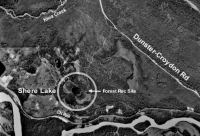 FIGURE 2. Annotated view of
FIGURE 2. Annotated view of
Shere Lake and surrounding country
Click
image to view 281K GIF |
|
This assessment concluded that the risk of brook trout
escapement in Shere Lake was low, however a follow-up assessment
was recommended to document the degree of channelization
of portion of the outlet located on private land, east of
the lake. Therefore, the objectives of the 1998 assessment
were to :
-
Assess the current status of brook trout in Shere
Lake;
-
Examine the portion of the lake's outlet flowing
through private land and;
-
Adjust the brook trout stocking program, if required.

Methods
An experimental, 91.2m sinking monofilament gill
net was set in Shere Lake on May 20,1998 according to
the methods described in "Fish Collection Methods and
Standards" (Resource Inventory Committee,
1997). The net was deployed May 20 at 8:10 PM and retrieved
on May 21 at 10:48 AM, for a total soak time of 14 hours,
38 minutes. The net was set in a NE-SW direction from the
west shore, approximately 200m ENE of the Forest Recreation
Site boat launch (Figure 3). The net was placed across depths
ranging from the surface (near shore) to approximately 3.5
m.
| |
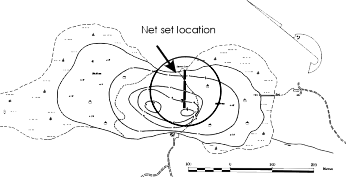
FIGURE 3. Shere Lake bathymetric map,
showing 1998 net set location
Click image to view 35K GIF |
|
All brook trout captured were sampled for fork
length, weight,sex,
and maturity.
Fin
rays were taken from brook trout for ageing purposes,
and otoliths were removed from a subset of fish for verification
of age techniques. Due to limited financial resources, a
stratified random sample of fin rays selected from 10 cm
size categories was sent to be aged. The structures were
delivered to Darlene
Gillespie of TimeMark Consulting Ltd. (Nanaimo, B.C.),
aged, and returned to the Ministry.
The portion of Shere Creek lying on private land was surveyed
by vehicle on May 21, and an interview was held with the
land owner to discuss the drainage and to document any observations
that he had with respect to brook trout presence in the
system.

Results and Discussion
| |
TABLE 2. Mean length, weight, and condition
of brook trout sampled in Shere Lake , May 21,
1998
| Attribute |
Mean |
Range |
SD |
| Length (mm) |
297 |
122-1050 |
68 |
| Weight (g)) |
455 |
20-1080 |
285 |
| Condition |
1.49 |
1.10-2.34 |
0.17 |
|
|
CATCH SUMMARY
The net catch yielded 86 eastern brook
trout (EB) and 8 lake chub (LKC), for a catch
per unit effort of 5.9 EB per net-hour. One fish was destroyed
in the net, and 3 others escaped. 32 female and 5 male fish
were identified, while the remaining 44 were classified
as 'unknown.' All but one fish examined were classified
as 'immature'. See Appendix
1 for individual brook trout sample data.
ANALYSIS
Size and Age Distribution
| |
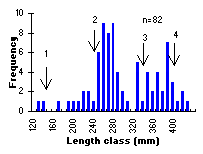
FIGURE 4. Length frequency distribution of
brook trout sampled in Shere Lake, May 21, 1998.
Arrows indicate mean length by age class
Click image to view 4K GIF |
|
The brook trout sampled in Shere Lake were dominated by
two-year-olds, exhibiting a mean length of 254 mm (Figure
4). Three- and four-year olds were also well represented,
however there was a size class gap between two- and three-year-old
fish. This gap is likely attributable to the difference
in mean weights at stocking of the 1996 and 1997 releases:
those stocked in 1996 averaged 10.95
g, while those in 1997 averaged 3.01 g. The 1996 yearlings
would therefore have grown relatively larger at the end
of their first growing season, compared to the 1997 yearlings.
The presence of yearlings in our sample may be due to an
error in the ageing process, since the lake was not stocked
with yearlings until after our survey. A secondary explanation
for this finding may be that some degree of natural recruitment
is occuring in Shere Lake, however all fish stocked since
1996 have theoretically been triploid, or sterile stock.
The yearlings observed in our sample would therefore have
to be progeny of the fertile stock that include the surviving
1993 and 1994 cohorts (Figure 5).
| |
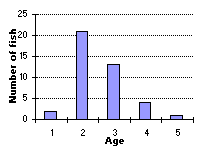
FIGURE 5. Age
frequency distribution of brook trout sampled
in Shere Lake, May 21, 1998
Click image to view 3K GIF |
|
The presence of numerous four-year-olds, weighing up to
1080 g, suggests that Shere Lake is receiving sustainable
levels of angling pressure and that larger fish continue
to be available to the recreational angler. However, it
may be that Shere Lake produces much larger fish and that
our results reflect a remnant population that is not retained
by anglers. Indeed, a 1988 article in B.C. Sport Fishing
reported a 2325 g, 489 cm brook trout which was caught in
the winter fishery on Shere Lake, suggesting that angling
efforts may target 'trophy' sized brook trout during
the winter months. If this is the case, then the larger
cohorts observed in our sample may contribute to this trophy
fishery, after they have grown through their fourth year.
| |
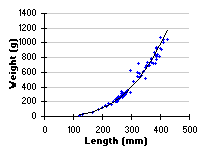
FIGURE 6. Length vs. weight of brook trout
sampled in Shere Lake, May 21, 1998
Click image to view 3K GIF |
|
Condition
The weight of Shere Lake brook trout increased according
the equation W = 8X10-6 x L3.1028
(R2=0.98), where W = weight in grams and L =
length in mm (Figure 6). There were no anomolies noted amongst
the fish sampled, and in general the fish appeared healthy
for their respective size. Two fish were very deep for their
length, and exhibited condition factors in excess of 2.0.
The mean condition factor of the brook trout population
was identical to that observed in Lasalle
Lake (West), which received releases on a bi-annual
basis. This supports the argument that Shere Lake is a highly
productive lake and can therefore support higher densities
of fish without compromising their condition (see below).

Management
Recommendations
The good growth and abundance of brook trout observed in
Shere Lake is likely due to the lake's shallow mean
depth (Table 1). The littoral area extends throughout the
entire lake basin (Miller 1981), thereby
increasing the lake's productive capacity (Wetzel
1975).
| |
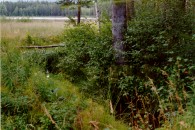
FIGURE 7. Shere Lake outlet, 1997
Click image to view 80K JPG |
|
Our investigation of the lake's outlet (Figure 7) yielded
little tangible evidence of brook trout escapement. When
viewed from the lake, the outlet was obstructed by a floating
vegetative mat and no discernible channel could be found.
When viewed from a road adjacent to the lake, an outlet
channel was observed that had negligible flow. The owner
of the property east of the lake, on which a portion of
the outlet flows, indicated that during high water brook
trout may be able to navigate downstream into a secondary
pond which lies on his property. From this pond, trout could
potentially escape into a modified channel that flows adjacent
to the CN Rail line. However, the likelihood of brook trout
escaping via this route is highly unlikely, as the modified
channel does not flow in a contiguous manner, and the habitat
quality in the channel is very poor.
Since 1996, all brook trout released into Shere Lake have
been sterile, or triploid, stock. Since these fish will
not develop reproductive products, it is expected that their
growth will exceed that of the fertile stock that were released
prior to this time. In addition, the mean weight of the
stock released in 1996 was in excess of 10 g, and it is
therefore likely that this cohort will be relatively larger
at a given age than the other fish released in prior and
subsequent years. We therefore expect that the future brook
trout fishery on Shere Lake should yield larger fish than
it currently does.
In summary, Shere Lake is currently producing a robust
brook trout fishery which is expected to produce good results
in the foreseeable future. Since the risk of brook trout
escapement is low, the Ministry will continue to stock the
lake with 2,500 fish on an annual basis.
Appendix 1.
Appendix 2.

Literature Cited
Barry, S. 1997. Channel assessment
of brook trout lakes, 1997. Omineca sub-Region. Ministry
of Environment, Lands and Parks, Prince George.
Miller, C. 1981. Shere Lake Inventory
Report. Ministry of Environment, Lands and Parks, Prince
George.
Resources Inventory Committee. 1997.Fish
Collection Methods and Standards, V. 4.0 Victoria.
Wetzel, R.G. 1975. Limnology. Philadelphia,
W.B. Saunders Company, 743 p.

For More Information:
Contact :Ted
Zimmerman
Sr. Fisheries Biologist, Omineca sub-Region
Prince George, B.C.
250-563-3860 |
